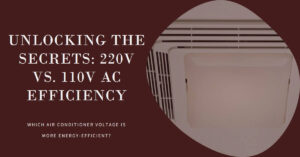Stabilizers play a crucial role in maintaining consistent voltage levels for electronic devices, ensuring their optimal performance and protection.
However, what happens when the input voltage to a stabilizer drops to low levels? Yes, stabilizers can work to some extent when the input voltage is too low. Stabilizers are designed to regulate voltage levels and maintain stability for electronic devices.
In this article, we will explore whether stabilizers can effectively function under such conditions, understanding the consequences and limitations involved.
Understanding Stabilizers
A stabilizer, also known as a voltage regulator, is a device designed to regulate and stabilize voltage levels supplied to electronic equipment.
It monitors the input voltage and adjusts it to a predetermined output voltage, shielding the connected devices from voltage fluctuations and irregularities.
Effects of Low Input Voltage
Low input voltage can have detrimental effects on electronic devices, including reduced functionality, increased power consumption, and potential damage to sensitive components.
In turn, this poses challenges for stabilizers, which rely on a stable input voltage to function optimally.
Stabilizer Operation with Low Input Voltage
When confronted with low input voltage, stabilizers face certain limitations in their ability to maintain stable output voltage.
Stabilizers are designed to regulate voltage levels and maintain stability for electronic devices. However, when faced with low input voltage, stabilizers face certain limitations in their ability to provide optimal voltage regulation.
The extent to which stabilizers can function effectively under low input voltage depends on several factors, such as the specific design of the stabilizer, its voltage regulation techniques, and adaptive control strategies.
While stabilizers may not be able to completely overcome the challenges posed by extremely low input voltage, they can still provide some degree of voltage stabilization.
Through voltage regulation techniques like boost converters, buck-boost converters, and adaptive control strategies, stabilizers attempt to compensate for the voltage drop and maintain a relatively stable output voltage.
However, it’s important to note that there are practical limits to what stabilizers can achieve under low input voltage conditions.
Read also my article: The Battle of Voltage: How High Voltage Affects Stabilizers.
Mechanisms of Stabilizer Functioning with Low Input Voltage
Stabilizers employ various voltage regulation techniques to address low input voltage scenarios. These techniques include boost converters, buck-boost converters, and transformer-based solutions.
Adaptive control strategies are also employed to adjust the stabilizer’s operation and optimize voltage regulation in the presence of low input voltage.
Stabilizer Design Considerations for Low Input Voltage
To enhance performance in low input voltage conditions, stabilizer design must consider voltage thresholds and detection mechanisms.
By accurately detecting low input voltage levels, stabilizers can trigger appropriate compensatory actions to mitigate the impact on output voltage stability.
Additionally, careful component selection and sizing are essential to ensure optimal performance and reliability.
Future Developments and Innovations
Ongoing research and advancements in stabilizer technology are focused on improving their performance under low input voltage conditions.
These developments include advanced control algorithms, intelligent sensing mechanisms, and more efficient voltage conversion techniques.
The aim is to provide stabilizers with enhanced capabilities to stabilize voltage even when facing extremely low input voltage scenarios.
Conclusion
While stabilizers are indispensable in maintaining voltage stability for electronic devices, their performance can be compromised when operating with low input voltage.
However, through careful design considerations and the integration of advanced control techniques, stabilizers can mitigate the impact of low input voltage and provide a degree of voltage stability.
As technology advances, further innovations in stabilizer design and control strategies will continue to address this challenge, ensuring reliable voltage regulation under diverse operating conditions

